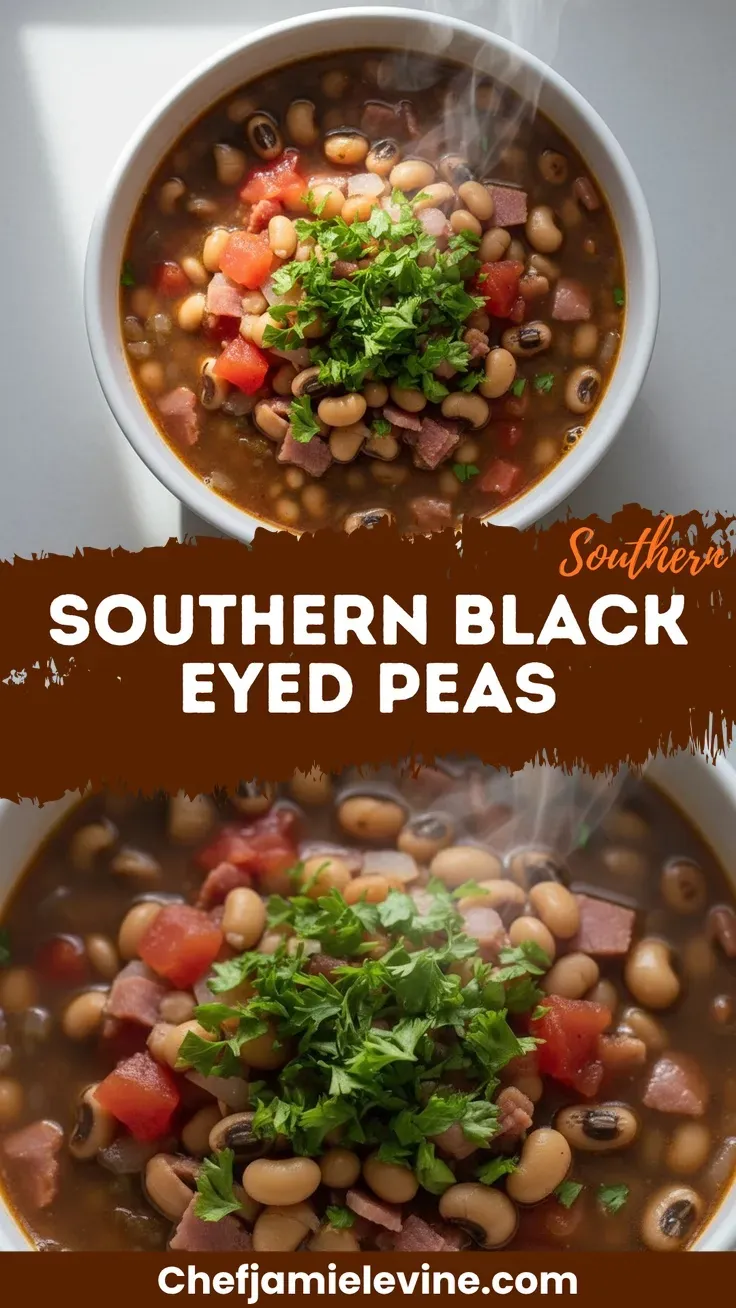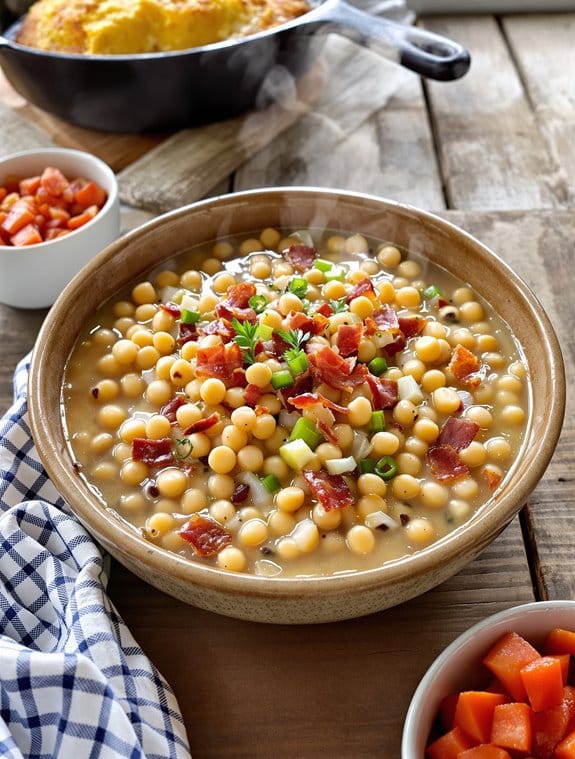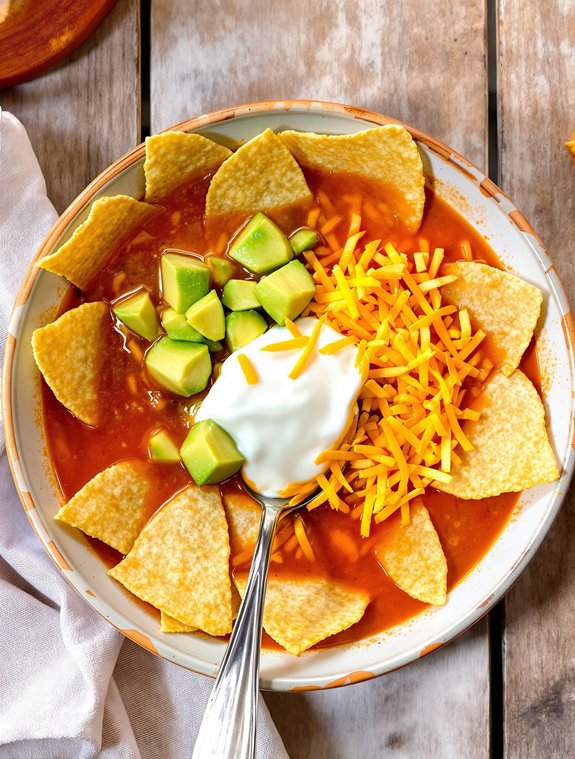Why You’ll Love these Southern Black Eyed Peas
There are three irresistible reasons why these Southern Black Eyed Peas will become your new favorite comfort food.
First, they’re incredibly flavorful, with smoky bacon, aromatic vegetables, and that perfect hint of heat from jalapeño.
Second, they’re wonderfully versatile—serve them alongside cornbread for a traditional meal or as a hearty side to grilled meats.
Finally, they’re practically foolproof, as long as you remember my little sorting tip (trust me, finding a metal screw in your dinner isn’t the excitement you’re looking for).
The secret to their rich texture? That clever trick of mashing some peas back into the pot. Pure Southern genius.
What Ingredients are in Southern Black Eyed Peas?
Southern Black Eyed Peas are a cornerstone of Southern cooking, blending smoky, savory flavors with hearty legumes to create the ultimate comfort food. There’s something magical about the way these humble ingredients come together in a pot, simmering slowly until they create a dish that feels like home. Whether you’re making them for a New Year’s Day tradition or just a cozy weeknight dinner, these black eyed peas deliver big flavor with relatively little effort.
- 1/4 lb smoked bacon, cut in 1/2-inch dice
- 1 small yellow onion, chopped
- 2 celery ribs, diced
- 1 fresh jalapeño, minced
- 1 garlic clove, minced
- 1 lb dried black-eyed peas, sorted for stones and debris
- 1 cup diced tomato
- 1/2 teaspoon pepper
- 1/8 teaspoon crushed red pepper flakes
- 1 bay leaf
- 1/2 teaspoon sugar
- 6 cups ham hock stock
- 1/4 teaspoon salt (to taste)
- 1/4 teaspoon liquid smoke (if using low-sodium chicken or vegetable stock)
- Olive oil (if needed during sautéing)
I can’t stress enough how important it’s to sort through your dried black-eyed peas before cooking. This might seem like a fussy step when you’re enthusiastic to get cooking, but trust me, dental work is much more expensive than the extra three minutes this takes. And the saltiness of your dish will vary dramatically depending on your stock—ham hock stock already brings plenty of salt to the party, while store-bought alternatives might need that liquid smoke addition to achieve that authentic Southern flavor profile. Remember, you can always add more seasonings, but fixing an over-salted pot of peas? That’s a challenge even the most seasoned Southern cook would rather avoid.
How to Make these Southern Black Eyed Peas

Start by frying 1/4 lb of diced smoked bacon in a large pot until it’s nicely browned and has released its flavorful fat. This creates the savory foundation that makes these peas so irresistible.
Once your bacon is crispy, add 1 small chopped yellow onion, 2 diced celery ribs, and 1 minced jalapeño to the pot. If things are looking a bit dry, don’t hesitate to drizzle in a little olive oil to help those aromatics soften properly.
Sauté this mixture over medium heat for about 5 minutes until the vegetables begin to soften, then add 1 minced garlic clove and stir for just 30 seconds—any longer and the garlic might burn and turn bitter.
Now comes the heart of the dish: add 1 lb of dried black-eyed peas (that you’ve carefully sorted through—seriously, nobody wants to bite down on a rock), 1 cup of diced tomatoes, 1/2 teaspoon pepper, 1/8 teaspoon of crushed red pepper flakes, 1 bay leaf, 1/2 teaspoon sugar, and 6 cups of ham hock stock.
If you’re using low-sodium chicken or vegetable stock instead, this is when you’ll want to add that 1/4 teaspoon of liquid smoke to mimic the traditional smoky flavor. Bring everything to a boil, then reduce the heat to low, cover the pot, and let it simmer gently for about an hour.
During this time, give the peas an occasional stir and check that there’s enough liquid—the peas should remain just barely covered.
When the peas have reached your desired tenderness (and this is a personal preference—some like them firmer, others more creamy), it’s time for a Southern cook’s secret technique.
Remove the bay leaf, then scoop out about 1/2 cup of the cooked peas and mash them into a chunky paste. Return this paste to the pot and stir it through—this thickens the broth and gives the dish that perfect, velvety consistency.
Finally, taste before adding that 1/4 teaspoon of salt. The ham hock stock can vary wildly in saltiness, so you might need more or less depending on your stock.
And there you have it—a pot of Southern black-eyed peas that would make any grandma proud.
Southern Black Eyed Peas Substitutions and Variations
While traditional Southern black-eyed peas are absolutely delicious as written, don’t feel like you need to stick rigidly to the recipe if you’re missing an ingredient or two.
No bacon? Use a smoked ham hock or turkey leg instead.
Vegetarians can skip the meat entirely and use vegetable stock with a touch more liquid smoke.
I’ve made these with green bell peppers when I didn’t have celery, and they turned out wonderfully.
Sometimes I’ll toss in a handful of collard greens during the last 15 minutes of cooking for extra nutrition.
No jalapeño? Try a dash of hot sauce or cayenne to taste.
What to Serve with Southern Black Eyed Peas
No matter how delicious your black-eyed peas turn out, they truly shine when paired with the right accompaniments.
I always serve mine with a side of hot cornbread for sopping up that smoky, savory broth. Trust me, nothing complements these peas better than golden-brown cornbread with a pat of melting butter.
For a complete Southern meal, add collard greens and some fried chicken or ham.
Rice makes a perfect base, too. The starch soaks up all those wonderful juices.
And don’t forget hot sauce on the table—some like it mild, others fiery. Your choice, of course.
Final Thoughts
These Southern black-eyed peas represent more than just a recipe to me—they’re a connection to history and tradition.
The careful sorting of peas (trust me, finding a metal screw once was enough dental anxiety for a lifetime), the slow simmering with smoky bacon, and that final step of mashing some peas to thicken the broth—it’s all part of a time-honored process.
I’ve learned that patience pays off here. The humble black-eyed pea transforms into something soulful and nourishing when given proper time and attention.
Isn’t that true of most worthwhile things in life?

Southern Black Eyed Peas
Ingredients
Equipment
Method
- In a large pot, cook the diced smoked bacon until crispy and the fat has rendered.
- Add the chopped yellow onion, diced celery ribs, and minced jalapeño to the pot. If needed, add a small drizzle of olive oil to help the vegetables soften.
- Sauté the vegetable mixture over medium heat for about 5 minutes until softened.
- Add the minced garlic and cook for just 30 seconds, stirring constantly to prevent burning.
- Add the sorted dried black-eyed peas, diced tomatoes, pepper, crushed red pepper flakes, bay leaf, sugar, and ham hock stock to the pot.
- If using low-sodium chicken or vegetable stock instead of ham hock stock, add the liquid smoke now.
- Bring the mixture to a boil, then reduce heat to low, cover, and simmer gently for about 1 hour, stirring occasionally.
- Check periodically to ensure the peas remain just barely covered with liquid.
- Once the peas have reached your desired tenderness, remove the bay leaf.
- Scoop out approximately 1/2 cup of cooked peas and mash them into a chunky paste.
- Return the mashed peas to the pot and stir to incorporate. This will thicken the broth and create a velvety consistency.
- Taste and add salt as needed, keeping in mind that ham hock stock can vary in saltiness.



